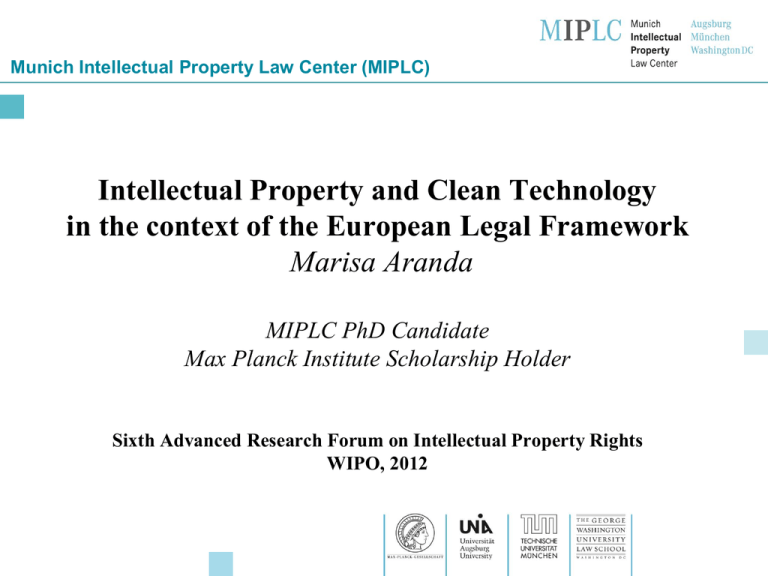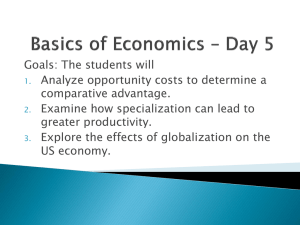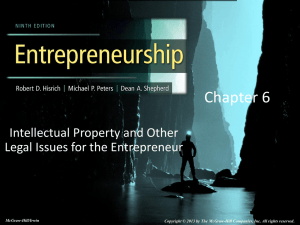Marisa Aranda
advertisement

Munich Intellectual Property Law Center (MIPLC) Intellectual Property and Clean Technology in the context of the European Legal Framework Marisa Aranda MIPLC PhD Candidate Max Planck Institute Scholarship Holder Sixth Advanced Research Forum on Intellectual Property Rights WIPO, 2012 Outline 1. Introduction 2. Statement of Problem 3. Research Questions 4. Structure of the Project 5. Methodology Marisa Aranda - May 2012 1 1. Introduction Concentrated Solar-Thermal Power (CSP) Plant © SCHOTT Solar AG Marisa Aranda - May 2012 2 2. Statement of Problem • The promotion of environmental sustainability and mitigation of climate change has been integrated within the EU Energy Policy. However, has it been integrated in other Union policies or activities? i.e. Intellectual Property? • Need of a Clean Technological Revolution. Problems associated with RD&D in this field: (i) requires substantial investment, (ii) public subsidies (funding shortfall?), (iii) private sector enough incentivized? Balance: Incentives – Dissemination/Access Diversification of EU Portfolio by Stimulating Innovation How best to achieve it?... Marisa Aranda - May 2012 3 3. Research Questions (i) A. Should the Environmental Integration Obligation, imposed by Article 11 TFEU and Article 37 CFREU, have an impact on European Intellectual Property Law and Policy? • Art. 11 TFEU: “ENVIRONMENTAL PROTECTION requirements MUST BE INTEGRATED into the definition and implementation of the UNION’S POLICIES AND ACTIVITIES, in particular with a view to promoting sustainable development”. • Art. 37 CFREU: “A high level of ENVIRONMENTAL PROTECTION and the improvement of the quality of the environment MUST BE INTEGRATED into the POLICIES OF THE UNION and ensured in accordance with the principle of sustainable development.” Marisa Aranda - May 2012 4 3. Research Questions (ii) B. Is the current Patent System fit for this purpose? How can appropriate Collaborative IP Mechanisms be implemented to foster incentives and to promote access in this field? B. What is the relationship between Patent Law and several Government Support Mechanisms geared towards developing clean technologies? Marisa Aranda - May 2012 5 4. Structure of the Project 1. Environmental Protection and Decrease of GHG: The Restricted Realm of Environmental Law? 1. Should the Environmental Integration Obligation have an impact on European IP Law and Policy? 1. In practice: What role does Environmental Protection play in European IP Law and Policy? 1. Patent Law and Government Support Mechanisms for Environmental Protection. What is the relationship? Marisa Aranda - May 2012 6 4.1. Environmental Protection: The restricted realm of Environmental Law? A. Environmental Law. • • B. Principle of Sustainable Development. Principle of Integration. Legal Framework of GHG Emissions. • International: UNFCCC & Kyoto Protocol. • European: TFEU, CFREU, EU GHG ETS, Renewable Energy Sources Directive, Action Plan for EPE: 20-2020,... C. Interaction btw. Environmental Law and IP Law. • • Implications of Environmental Law for IP Law. Clean Technology: No uniform terminology. Renewable Energy and Smart Grid Technologies • Clean Energy Technological Revolution. Marisa Aranda - May 2012 7 4.2. Environmental Integration Obligation: Impact on European IP Law and Policy? A. Legal reasoning. • • • The evolvement of EU environmental policy. How does EU Law affect Intellectual Property? Conciliation of EU’s environmental and economic aims: Articles 7 and 11 of the TFEU. Article 37 of the CFREU. B. Governance reasoning. • • Relevance to Environmental Policy. Relevance to EU Law enforcers. C. Economic reasoning. • • Theory of environmental economics. Social welfare goal. Marisa Aranda - May 2012 8 4.3. In Practice: What role does Environmental Protection play in European IP Law & Policy? A. Is IP Law an Incentive or a Barrier? • • Relevant IPRs: Patents & Trade Secrets. Conflicting views on the role of IPRs. B. The Patent System: Encouraging Innovation? • • • Administrative Patent Policy. Substantive Patent Law. Non-discrimination under Article 27(1) TRIPS. C. Licensing Structures & Collaborative IP Mechanisms: Appropriate to foster incentives & promote access? • • • • Private Public Partnerships (i.e. SET-Plan) Patent Pools (i.e. Desertec Industrial Initiative) Standards Agreements (i.e. EU Smart Grid Standardization) Open Innovation (i.e. Concentrated Solar Power Open Source Initiative) Marisa Aranda - May 2012 9 4.4. Patent Law and Government Support Mechanisms A. State Aid for Environmental Protection. • State Aid: Article 107(1) TFEU • Environmental Aid Exemption: Articles 107(3)(b) & (c) TFEU General Block Exemption Regulation (Environmental Aid) Community Guidelines on State Aid for Environ. Protection B. Relationship between Patent Law & Support Mechanisms introduced by Environmental Law. • i.e. R&D grants: Proposal: Government authorities to oblige “nonexclusive” licensing with publicly funded innovations? Marisa Aranda - May 2012 10 5. Methodology • Analysis of Legislation: International, EU, Intellectual Property & Competition. • Study of Literature: Books, Articles, etc. • Examination of existing EU Case Studies: i.e. SET-Plan, Desertec, EU Smart Grid Standardization, Concentrated Solar Power Open Source Initiative,... • Conducting Interviews with relevant authorities and enterprises in the field. • Attendance at Workshops & Conferences. Marisa Aranda - May 2012 11 THANK YOU FOR YOUR ATTENTION!!! marisa.aranda@miplc.de Marisa Aranda - May 2012








